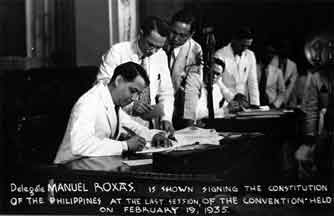1935 Commonwealth of Philippines Declared
In 1935, the Philippines approved a new constitution under which they were granted independence as a Commonwealth. Full independence was to come ten year later.
The Philippines, had been a U.S. colony since 1898, following the Spanish-American War. Over the years, the Filipino people sought greater autonomy and a path toward independence. In response to this desire, the U.S. Congress passed the Tydings-McDuffie Act in 1934, which laid the groundwork for the formation of a Philippine Commonwealth government with a ten-year transition period.
In accordance with the act, a constitutional convention was held in the Philippines to draft a new constitution. The resulting document, which was approved by both the Philippine electorate and U.S. President Franklin D. Roosevelt, established the Commonwealth of the Philippines on November 15, 1935. Manuel L. Quezon was elected as the first President of the Philippine Commonwealth.
The 1935 Constitution provided for a strong executive, a unicameral National Assembly, and an independent judiciary. It also included provisions for social justice and the promotion of the general welfare of the people. The Philippine Commonwealth government aimed to address various social, economic, and political issues in the lead-up to full independence.
The ten-year transitional period was intended to give the Philippines time to prepare for full independence. However, World War II disrupted this timeline, as the country was invaded and occupied by Japanese forces in 1942. The Philippines was liberated by the U.S. and Filipino forces in 1944-45.
 >
>